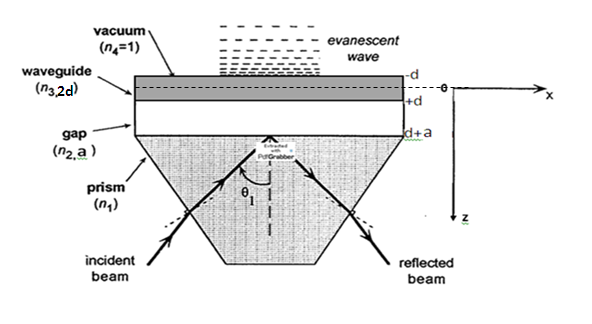eISSN: 2576-4543


Mini Review Volume 6 Issue 4
1Physics Department, Faculty of Sciences, University Saâd Dahlab of Blida, Algeria
2Lycée Mohamed Boudiaf, Ksar-El-Boukhari, Algeria
Correspondence: S Ghezali, Physics Department, Faculty of Sciences, University Saâd Dahlab of Blida, Road of Soumaa, Blida 09000, Algeria
Received: November 02, 2022 | Published: November 14, 2022
Citation: Ghezali S, Slimani M. Transverse magnetic mode excitation in an atomic mirror. Phys Astron Int J. 2022;6(4):156-160. DOI: 10.15406/paij.2022.06.00269
We present a study of a transverse magnetic mode excitation in a multi-layer atomic mirror. We give the continuity relationships at the interfaces of the setting.1 We deduce the transverse and parallel components of the electric field through the atomic mirror and then the total component. We show that there is no enhancement of the electric field in the vaccum contrarily to the transverse electric field excitation.2
We introduce a detailed study of a transverse magnetic mode excitation in an atomic mirror. It is easy to demonstrate that in this geometry, we have: ∂∂y=0∂∂y=0 . There are two independant solutions of the Maxwell equations.1 One introduces a TE excitation (Ey, Bx and Bz). The other one gives a TM excitation (By, Ex and Ez) coupled between them.

Figure 1 Resonant dielectric structure: the waveguide (Ti02, refraction index n3=2.387 and thickness 2d=67.9nm) is separated from the glass prism (LaSFN18, refraction index n1=1.893) by a layer of low index, the gap, (SiO2, thickness a=700nm, refraction index n2=1.49). The dielectric layers are deposited by a laser beam at λλ =780nm. The fourth medium is vacuum (refraction index n4=1).
Maxwell equations:
The Maxwell equations [1, 3] give:
→∇∧→E=−1C∂→B∂t→∇∧→E=−1C∂→B∂t
→∇∧→H=4πC→J+1C∂→D∂t→∇∧→H=4πC→J+1C∂→D∂t
→∇.→E=4πρ→∇.→E=4πρ
→∇.→B=0→∇.→B=0
In order to introduce the right relationships, we present the electric field in the multi-layer system for a TE excitation.
E(1)y=A exp(−iγ1z)+A\ exp(iγ1z)E(1)y=Aexp(−iγ1z)+A\exp(iγ1z)
E(2)y=B exp(β2z)+B\ exp(−β2z)E(2)y=Bexp(β2z)+B\exp(−β2z)
E(3)y=C exp(−iγ3z)+C\ exp(iγ3z)E(3)y=Cexp(−iγ3z)+C\exp(iγ3z)
E(4)y=D exp(β4z)E(4)y=Dexp(β4z)
For a transverse magnetic mode excitation, we give the two components of the electric field deduced from the Maxwell equations. The magnetic field By for the TM excitation has the same form as the perpendicular electric field Ey for the TE excitation.1 See the above equations.
→ET=Ex→i+Ez→k→ET=Ex→i+Ez→k
→∇∧→E=|i∂∂xExj∂∂y0k∂∂zEz|=i(∂Ez∂y)−j(∂Ez∂x−∂Ex∂z)+k(−∂Ex∂y)=iK0→B→∇∧→E=∣∣ ∣ ∣∣i∂∂xExj∂∂y0k∂∂zEz∣∣ ∣ ∣∣=i(∂Ez∂y)−j(∂Ez∂x−∂Ex∂z)+k(−∂Ex∂y)=iK0→B
E(1)x(z)=γ1K0n21(−A exp(−iγ1z)+A\ exp(iγ1z))E(1)x(z)=γ1K0n21(−Aexp(−iγ1z)+A\exp(iγ1z))
E(2)x(z)=β2iK0n22(B exp(β2z)−B\ exp(−β2z))E(2)x(z)=β2iK0n22(Bexp(β2z)−B\exp(−β2z))
E(3)x(z)=γ3K0n23(−C exp(−iγ3z)+C\ exp(iγ3z))E(3)x(z)=γ3K0n23(−Cexp(−iγ3z)+C\exp(iγ3z))
E(4)x(z)=β4iK0n24D exp(β4z)E(4)x(z)=β4iK0n24Dexp(β4z)
The polarisation of the transmitted wave in the second medium is obtained from the Snell-Descartes law.
de (21) Ex=1iK0n2∂By∂zde (20) iK0By=(∂Ex∂z−∂Ez∂x)de(21)Ex=1iK0n2∂By∂zde(20)iK0By=(∂Ex∂z−∂Ez∂x)
iμεK0Ez=−iKxByEz=−KxK0n2ByiμεK0Ez=−iKxByEz=−KxK0n2By
B(1)y=A exp(−iγ1z)+A\ exp(iγ1z)B(1)y=Aexp(−iγ1z)+A\exp(iγ1z)
B(2)y=B exp(β2z)+B\ exp(−β2z)B(2)y=Bexp(β2z)+B\exp(−β2z)
B(3)y=C exp(−iγ3z)+C\ exp(iγ3z)B(3)y=Cexp(−iγ3z)+C\exp(iγ3z)
B(4)y=D exp(β4z)B(4)y=Dexp(β4z)
y21=n21k20cos2θy21=n21k20cos2θ
β22=(n21sinθ−n2)K20β22=(n21sinθ−n2)K20
y23=(n23−n21sin2θ)K20y23=(n23−n21sin2θ)K20
β24=(n21sin2θ−n24)K20β24=(n21sin2θ−n24)K20
Ex=1iK0n2∂By∂zEx=1iK0n2∂By∂z
E(1)x(z)=γ1K0n21(−A exp(−iγ1z)+A\ exp(iγ1z))E(1)x(z)=γ1K0n21(−Aexp(−iγ1z)+A\exp(iγ1z))
E(2)x(z)=β2iK0n22(B exp(β2z)−B\ exp(−β2z))E(2)x(z)=β2iK0n22(Bexp(β2z)−B\exp(−β2z))
E(3)x(z)=γ3K0n23(−C exp(−iγ3z)+C\ exp(iγ3z))E(3)x(z)=γ3K0n23(−Cexp(−iγ3z)+C\exp(iγ3z))
E(4)x(z)=β4iK0n24D exp(β4z)E(4)x(z)=β4iK0n24Dexp(β4z)
We give the continuity equations in the multi-layer system:
→s.(→D2−→D1)=0→s.(→D2−→D1)=0
n2iE1i(z)=n2i+1E1i+1(z)n2iE1i(z)=n2i+1E1i+1(z)
→s×(→E2−→E1)=→0→s×(→E2−→E1)=→0
Ex(i)=Ex(i+1) i=1;2;3Ex(i)=Ex(i+1)i=1;2;3 at each interface.
→s×(→H2−→H1)=→0→s×(→H2−→H1)=→0
B1y(d+a)=B2y(d+a)B1y(d+a)=B2y(d+a)
E1x(d+a)=E2x(d+a)E1x(d+a)=E2x(d+a)
B2y(d)=B3y(d)B2y(d)=B3y(d)
E2x(d)=E3x(d)E2x(d)=E3x(d)
B3y(−d)=B4y(−d)B3y(−d)=B4y(−d)
E3x(−d)=E4x(−d)E3x(−d)=E4x(−d)
n2iEz(i)=n2i+1Ez(i+1)n2iEz(i)=n2i+1Ez(i+1)
for i=1,2,3 for each interface in the multi-layer.Aexp(−iγ1(d+a))=−Ae‵xp(−iγ1(d+a))+Bexp(β2(d+a))+Be‵xp(−β2(d+a))
γ1n21K0Aexp(−iγ1(d+a))=γ1n21K0−Ae‵xp(−iγ1(d+a))−β2in21K0[Bexp(β2(d+a))−Be‵xp(−β2(d+a))
0=−Bexp(β2d)−B\exp(−β2d)+Cexp(−iγ3d)+C\exp(iγ3d)
0=+β2in22K0[Bexp(β2d)−B\exp(−β2d)+γ3n23K0[Cexp(−iγ3d)−C\exp(iγ3d)
0=−Cexp(iγ3d)+C\exp(−iγ3d)+Dexp(−β4d)
0=β4iK0Bexp(−β4d)−γ3n23K0[Cexp(iγ3d)−C\exp(−iγ3d)
We extract some factors from the matrix and call them I, II, III, IV, V, VI and VII:
I=exp(−iγ1(d+a))
II=exp(iγ1(d+a))
III=exp(β2d)
IV=exp(−β2d)
V=exp(−iγ3d)
VI=exp(iγ3d)
VII=exp(−β4d)
I1=|1−1−10β2in22K0−γ3n23K0γ3n23K000exp(2γ3d)exp(−2γ3d)−10γ3n23K0exp(2γ3d)−γ3n23K0exp(−2γ3d) β4iK0| I2=|1−1−10−β2in22K0−γ3n23K0γ3n23K000exp(2γ3d)exp(−2γ3d)−10γ3n23K0exp(2γ3d)−γ3n23K0exp(−2γ3d) β4iK0|
I1=2iK20[γ3n23(β2n22+β4)cos(2γ3d)−(γ23n43−β2β4n22)sin(2γ3d)]
I2=2iK20[γ3n23(−β2n22+β4)cos(2γ3d)−(γ23n43+β2β4n22)sin(2γ3d)]
X=γ3n23(β2n22+β4)cos2γ3d−(γ23n43−β2β4n22)sin2γ3d
Y=γ3n23(−β2n22+β4)cos2γ3d−(γ23n43+β2β4n22)sin2γ3d
det A=2K30(G+iH) det A=2K30(G+iH)
det A=2K30(G+iH) exp(iγ3(d+a)) exp(−β4d)
With:G=β2n22(Xexp(β2a)+Yexp(−β2a))
H=γ1n21(−Xexp(β2a)+Yexp(−β2a))
(−1−exp(β2a)−exp(−β2a)000−γ1n21K0β2in22K0exp(β2a)−β2in22K0exp(−β2a)000011−1−100−β2in22K0β2in22K0−γ3n23K0γ3n23K00000exp(2iγ3d)exp(−2iγ3d)−1000γ3n23K0exp(2iγ3d)−γ3n23K0exp(−2iγ3d)β4iK0)
det A\=−β2in22K0exp(β2a)|1−1−10β2in22K0−γ3n23K0γ3n23K000exp(2γ3d)exp(−2γ3d)−10γ3n23K0exp(2γ3d)−γ3n23K0exp(−2γ3d) β4iK0|−β2in22K0exp(−β2a)|1−1−10−β2in22K0−γ3n23K0γ3n23K000exp(2γ3d)exp(−2γ3d)−10γ3n23K0exp(2γ3d)−γ3n23K0exp(−2γ3d) β4iK0|
−γ1n21K0exp(β2a)|1−1−10β2in22K0−γ3n23K0γ3n23K000exp(2γ3d)exp(−2γ3d)−10γ3n23K0exp(2γ3d)−γ3n23K0exp(−2γ3d) β4iK0|+γ1n21K0exp(−β2a)|1−1−10−β2in22K0−γ3n23K0γ3n23K000exp(2γ3d)exp(−2γ3d)−10γ3n23K0exp(2γ3d)−γ3n23K0exp(−2γ3d) β4iK0|
detA\=−(β2in22K0+γ1n21K0)exp(β2a) I1−(β2in22K0−γ1n21K0)exp(−β2a) I2
detA\=−2K30(G−iH) exp(−iγ3(d+a)) exp(−β4d)
j=2K30 exp(−iγ3(d+a)) exp(−β4d)
detA=j(G+iH)
: j* is the conjugate of j
detA\=−j∗(G-iH)
(1−1−exp(−β2a)000−γ1n21K0−γ1n21K0−β2in22K0exp(−β2a)000001−1−1000β2in22K0−γ3n23K0γ3n23K00000exp(2iγ3d)exp(−2iγ3d)−1000γ3n23K0exp(2iγ3d)−γ3n23K0exp(−2iγ3d)β4iK0)
det B=−2γ1n21K0 I1 with I1=2iK20 X
det B=−4iγ1n21K30 X exp(-d(β2+β4))
(1−exp(β2a)−1000−γ1n21K0β2in22K0exp(β2a)−γ1n21K0000010−1−100−β2in22K00−γ3n23K0γ3n23K00000exp(2iγ3d)exp(−2iγ3d)−1000γ3n23K0exp(2iγ3d)−γ3n23K0exp(−2iγ3d)β4iK0)
det B\=2γ1n21K0 I2 with I2=2iK20 Y
det B\=4iγ1n21K30 Y exp(d(β2−β4))
(1−exp(β2a)−exp(−β2a)−100−γ1n21K0β2in22K0exp(β2a)−β2in22K0exp(−β2a)−γ1n21K0000110−100−β2in22K0β2in22K00γ3n23K000000exp(−2iγ3d)−10000−γ3n23K0exp(−2iγ3d)β4iK0)
det C=2β2γ1in22n21K20 |−γ1K0000exp(−2γ3d)−10−γ3K0exp(−2γ3d)β4iK0|
det C=4β2γ1n21n22K30(β4−iγ3n23) exp(−2iγ3d)
det C=4β2γ1n21n22K30(β4−iγ3n23) exp(−2iγ3d) exp(−β4d)
(1−exp(β2a)−exp(−β2a)0−10−γ1n11K0β2in22K0exp(β2a)−β2in22K0exp(−β2a)0−γ1n21K00011−1000−β2in22K0β2in22K0−γ3n23K000000exp(2iγ3d)0−1000γ3n23K0exp(2iγ3d)0β4iK0)
det C\=−4β2γ1in21n22K30(β4+iγ3n23) exp(2iγ3d)
det C\=−4β2γ1in21n22K30(β4+iγ3n23) exp(2iγ3d) exp(−β4d)
(1−exp(β2a)−exp(−β2a)00−1−γ1K0β2iK0exp(β2a)−β2iK0exp(−β2a)00−γ1K0011−1−100−β2iK0β2iK0−γ3K0γ3K00000exp(2iγ3d)exp(−2iγ3d)0000γ3K0exp(2iγ3d)−γ3K0exp(−2iγ3d)0)
det D=−8iγ1γ3β2K30
The coefficients A, A\, B ,B\, C, C\, D are given by the following relationship:
Adet A=A\det A\=Bdet B=B\det B\=Cdet C=C\det C\=Ddet D
A\=−A j*(G−iH)j (G+iH)
B=−A4iγ1XK30J(G+iH) exp(−d(β2+β4))
B\=A4iγ1YK30J(G+iH) exp(−d(β2−β4))
C=A4β2γ1K30J(G+iH) (β4−iγ3) exp(−dβ4) exp(−iγ3d)
C\=−A4β2γ1K30J(G+iH) (β4+iγ3) exp(−dβ4) exp(iγ3d)
D=−A8iγ1γ3β2K30j (G+iH)
Results:
We take an incidence angle close to the critical angle (optimum of transmission in the TE mode). See reference.1
θinc =520
{Ex=1iK0n2∂By∂zEz=−KxK0n2By
→ET=Ex →i+Ez →k
→ET(4)=Ex(4) →i+Ez(4) →k
→ET=β4iK0n4D exp(β4z) →i−KxK0n4D exp(β4z) →k
→ET(4).conj(→ET(4))=|D|2 exp(2β4z)
→ET(1)=γ1K0n21(−Aexp(−iγ1z)+A`exp(iγ1z)) →i−KxK0n21(Aexp(−iγ1z)+A`exp(iγ1z)) →k
{Ex=1iK0n2∂By∂zEz=−KxK0n2By
→ET=Ex →i+Ez →k
→ET(4)=Ex(4) →i+Ez(4) →k
→ET=β4iK0n4D exp(β4z) →i−KxK0n4D exp(β4z) →k
→ET(4).conj(→ET(4))=|D|2 exp(2β4z)
→ET(1)=γ1K0n21(−Aexp(−iγ1z)+A`exp(iγ1z)) →i−KxK0n21(Aexp(−iγ1z)+A`exp(iγ1z)) →k
→ET(1).conj(→ET(1))=|A|2n41
We notice that the electric field is bigger in the gap and then decreases in the vaccum where it is smaller than in the prism.
The transmission factor is given by:4
T=|→ET(4) z=−d →ET(1) z=d+a |2=→ET(4) . conj(→ET(4)) z=−d →ET(1) . conj(→ET(1)) z=d+a
T=(4γ1γ3β2)2n22n23(G2+H2)
We conclude that there is no enhancement in the vaccum for the electric field and there is no technological progress or advantage for this kind of excitation.1,5-7
None.
None.

©2022 Ghezali, et al. This is an open access article distributed under the terms of the, which permits unrestricted use, distribution, and build upon your work non-commercially.